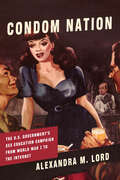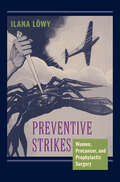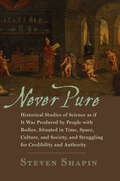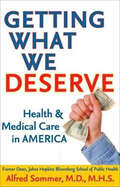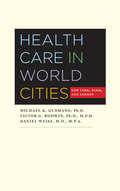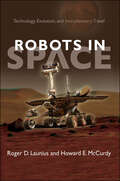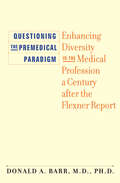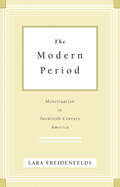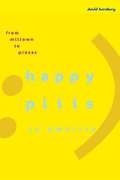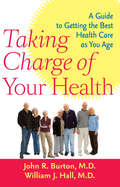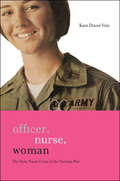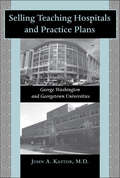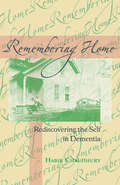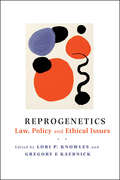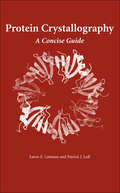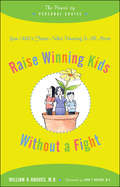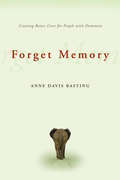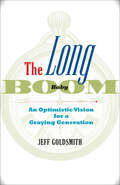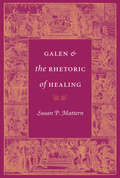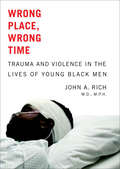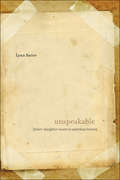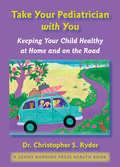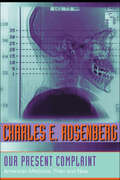- Table View
- List View
Condom Nation: The U.S. Government's Sex Education Campaign from World War I to the Internet
by Alexandra M. LordAn award-winning history of the U.S. Public Health Service’s haphazard efforts to educate Americans about sex for more than a century.Since launching its first sex ed program during World War I, the Public Health Service has dominated federal sex education efforts. Alexandra M. Lord draws on medical research, news reports, the expansive records of the Public Health Service, and interviews with former surgeons general to examine these efforts, from early initiatives through the administration of George W. Bush.Giving equal voice to many groups in America—middle class, working class, black, white, urban, rural, Christian and non-Christian, scientist and theologian—Lord explores how federal officials struggled to create sex education programs that balanced cultural and public health concerns. She details how the Public Health Service left an indelible mark on federally and privately funded sex education programs through partnerships and initiatives with community organizations, public schools, foundations, corporations, and religious groups. With engaging and insightful analysis, Lord explains how tensions among these organizations exacerbated existing controversies about sexual behavior. She also discusses why the Public Health Service’s promotional tactics sometimes fueled public fears about the federal government’s goals in promoting, or not promoting, sex education.Award for the Public Understanding of Science, 2010, British Medical Association’s Board of ScienceFirst Prize, Popular Medicine, British Medical Association 2010 Book Awards
Preventive Strikes: Women, Precancer, and Prophylactic Surgery
by Ilana LöwyWinner, 2011 Best Book in the History of Medicine, European Association for the History of Medicine and HealthModern scientific tools can identify a genetic predisposition to cancer before any disease is detectable. Some women will never develop breast or ovarian cancer, but they nevertheless must decide, as a result of genetic testing, whether to have their breasts and ovaries removed to avoid the possibility of disease. The striking contrast between the sophistication of diagnosis and the crudeness of preventive surgery forms the basis of historian Ilana Löwy’s important study.Löwy traces the history of prophylactic amputations through a century of preventive treatment and back to a long tradition of surgical management of gynecological problems. In the early twentieth century, surgeons came to believe that removing precancerous lesions—a term difficult to define even today—averted the danger of malignancy. This practice, Löwy finds, later led to surgical interventions for women with a hereditary predisposition to cancer but no detectable disease. Richly detailed stories of patients and surgeons in the United States, France, and the United Kingdom allow Löwy to compare the evolution of medical thought and practice—and personal choice—in these different cultures.Preventive Strikes aims to improve our understanding of professional, social, and cultural responses to cancer in the twenty-first century and to inform our reflections about how values are incorporated into routine medical practices.Ilana Löwy
When Your Loved One Has Dementia: A Simple Guide for Caregivers
by Joy A. Glenner Jean M. Stehman Judith Davagnino Margaret J. Galante Martha L. GreenEighty percent of persons with dementia live at home, and the family members caring for them are often overwhelmed by the enormous responsibility and the complexities of care. This book is designed to support the caregivers and help them understand the needs and feelings of the person for whom they are caring. A central focus is the goal of sustaining a loving family relationship between the caregiver and the patient. Developed from a training program for professionals and family caregivers, this book teaches the basics of dementia care while emphasizing communication, understanding and acceptance, and personal growth through the caregiving experience. The result is a guide that integrates the practicalities of caregiving with the human emotions that accompany it.
Never Pure: Historical Studies of Science as if It Was Produced by People with Bodies, Situated in Time, Space, Culture, and Society, and Struggling for Credibility and Authority
by Steven ShapinSteven Shapin argues that science, for all its immense authority and power, is and always has been a human endeavor, subject to human capacities and limits. Put simply, science has never been pure. To be human is to err, and we understand science better when we recognize it as the laborious achievement of fallible, imperfect, and historically situated human beings.Shapin’s essays collected here include reflections on the historical relationships between science and common sense, between science and modernity, and between science and the moral order. They explore the relevance of physical and social settings in the making of scientific knowledge, the methods appropriate to understanding science historically, dietetics as a compelling site for historical inquiry, the identity of those who have made scientific knowledge, and the means by which science has acquired credibility and authority.This wide-ranging and intensely interdisciplinary collection by one of the most distinguished historians and sociologists of science represents some of the leading edges of change in the scholarly understanding of science over the past several decades.
Getting What We Deserve: Health and Medical Care in America
by Alfred SommerOne of America's leading public health experts finds a host of ills in this country's health care system:• The United States spends nearly twice as much on health care as the rest of the developed world, yet has higher infant mortality rates and shorter longevity than most nations.• We have access to many different drugs that accomplish the same end at varying costs, and nearly all are cheaper abroad.• Our life span had doubled over the past century before we developed effective drugs to treat most diseases or even considered altering the human genome.• The benefits of almost all newly developed treatments are marginal, while their costs are high.In his blunt assessment of the state of public health in America, Alfred Sommer argues that human behavior has a stronger effect on wellness than almost any other factor.Despite exciting advances in genomic research and cutting-edge medicine, Sommer explains, most illness can be avoided or managed with simple, low-tech habits such as proper hand washing, regular exercise, a balanced diet, and not smoking. But, as he also shows, this is easier said than done.Sommer finds that our fascination with medical advances sometimes keeps us from taking responsibility for our individual well-being. Instead of focusing on prevention, we wait for medical science to cure us once we become sick.Humorous, sometimes acerbic, and always well informed, Sommer's thought-provoking book will change the way you look at health care in America.
Getting What We Deserve: Health & Medical Care in America
by MD Alfred SommerA leading public health expert presents a frank diagnosis of the U.S. healthcare system and the role we all play in our own wellness.Through his groundbreaking work in clinical medicine and public health, Alfred Sommer has saved countless lives. But doctors can only do so much. In this blunt assessment of the American healthcare system, Sommer argues that human behavior has a stronger effect on wellness than almost any other factor.Despite exciting advances in genomic research and cutting-edge medicine, the best defense against most illness remains simple, low-tech habits such as proper hand washing, regular exercise, a balanced diet, and not smoking. But rather than focusing on wellness, many Americans would rather wait for medical science to cure them once they become sick. Sommer argues that this overconfidence in medical technology comes at a terrible cost.The benefits of almost all newly developed treatments are marginal, while their costs are high. The United States spends nearly twice as much on health care as the rest of the developed world, yet has higher infant mortality rates and shorter longevity than most nations. In this engaging and well-informed study, Sommer makes a persuasive chase for changing the way Americans approach healthcare.
Health Care in World Cities: New York, Paris, and London
by Michael K. Gusmano Victor G. Rodwin Daniel WeiszNew York. London. Paris. Although these cities have similar sociodemographic characteristics, including income inequalities and ethnic diversity, they have vastly different health systems and services. This book compares the three and considers lessons that can be applied to current and future debates about urban health care. Highlighting the importance of a national policy for city health systems, the authors use well-established indicators and comparable data sources to shed light on urban health policy and practice. Their detailed comparison of the three city health systems and the national policy regimes in which they function provides information about access to health care in the developed world’s largest cities. The authors first review the current literature on comparative analysis of health systems and offer a brief overview of the public health infrastructure in each city. Later chapters illustrate how timely and appropriate disease prevention, primary care, and specialty health care services can help cities control such problems as premature mortality and heart disease. In providing empirical comparisons of access to care in these three health systems, the authors refute inaccurate claims about health care outside of the United States.
Robots in Space: Technology, Evolution, and Interplanetary Travel (New Series in NASA History)
by Roger D. Launius Howard E. McCurdy2008 Outstanding Academic Title, Choice MagazineGiven the near incomprehensible enormity of the universe, it appears almost inevitable that humankind will one day find a planet that appears to be much like the Earth. This discovery will no doubt reignite the lure of interplanetary travel. Will we be up to the task? And, given our limited resources, biological constraints, and the general hostility of space, what shape should we expect such expeditions to take?In Robots in Space, Roger Launius and Howard McCurdy tackle these seemingly fanciful questions with rigorous scholarship and disciplined imagination, jumping comfortably among the worlds of rocketry, engineering, public policy, and science fantasy to expound upon the possibilities and improbabilities involved in trekking across the Milky Way and beyond. They survey the literature—fictional as well as academic studies; outline the progress of space programs in the United States and other nations; and assess the current state of affairs to offer a conclusion startling only to those who haven't spent time with Asimov, Heinlein, and Clarke: to traverse the cosmos, humans must embrace and entwine themselves with advanced robotic technologies.Their discussion is as entertaining as it is edifying and their assertions are as sound as they are fantastical. Rather than asking us to suspend disbelief, Robots in Space demands that we accept facts as they evolve.
Questioning the Premedical Paradigm: Enhancing Diversity in the Medical Profession a Century after the Flexner Report
by Donald A. BarrThis book raises fundamental questions about the propriety of continuing to use a premedical curriculum developed more than a century ago to select students for training as future physicians for the twenty-first century. In it, Dr. Donald A. Barr examines the historical origins, evolution, and current state of premedical education in the United States. One hundred years ago, Abraham Flexner's report on Medical Education in the United States and Canada helped establish the modern paradigm of premedical and medical education. Barr’s research finds the system of premedical education that evolved to be a poor predictor of subsequent clinical competency and professional excellence, while simultaneously discouraging many students from underrepresented minority groups or economically disadvantaged backgrounds from pursuing a career as a physician. Analyzing more than fifty years of research, Barr shows that many of the best prospects are not being admitted to medical schools, with long-term adverse consequences for the U.S. medical profession. The root of the problem, Barr argues, is the premedical curriculum—which overemphasizes biology, chemistry, and physics by teaching them as separate, discrete subjects. In proposing a fundamental restructuring of premedical education, Barr makes the case for parallel tracks of undergraduate science education: one that would largely retain the current system; and a second that would integrate the life sciences in a problem-based, collaborative learning pedagogy. Barr argues that the new, integrated curriculum will encourage greater educational and social diversity among premedical candidates without weakening the quality of the education. He includes an evaluative research framework to judge the outcome of such a restructured system.This historical and cultural analysis of premedical education in the United States is the crucial first step in questioning the appropriateness of continuing a hundred-year-old, empirically dubious pedagogical model for the twenty-first century.
The Modern Period: Menstruation in Twentieth-Century America
by Lara FreidenfeldsWinner, 2010 Emily Toth Award for Best Book in Women’s Studies, Popular Culture Association/American Culture AssociationThe Modern Period examines how and why Americans adopted radically new methods of managing and thinking about menstruation during the twentieth century. In the early twentieth century women typically used homemade cloth "diapers" to absorb menstrual blood, avoided chills during their periods to protect their health, and counted themselves lucky if they knew something about menstruation before menarche. New expectations at school, at play, and in the workplace, however, made these menstrual traditions problematic, and middle-class women quickly sought new information and products that would make their monthly periods less disruptive to everyday life.Lara Freidenfelds traces this cultural shift, showing how Americans reframed their thinking about menstruation. She explains how women and men collaborated with sex educators, menstrual product manufacturers, advertisers, physical education teachers, and doctors to create a modern understanding of menstruation. Excerpts from seventy-five interviews—accounts by turns funny and moving—help readers to identify with the experiences of the ordinary people who engineered these changes. The Modern Period ties historical changes in menstrual practices to a much broader argument about American popular modernity in the twentieth century. Freidenfelds explores what it meant to be modern and middle class and how those ideals were reflected in the menstrual practices and beliefs of the time. This accessible study sheds new light on the history of popular modernity, the rise of the middle class, and the relationship of these phenomena to how Americans have cared for and managed their bodies.
Happy Pills In America: From Miltown To Prozac
by David HerzbergValium. Paxil. Prozac. Prescribed by the millions each year, these medications have been hailed as wonder drugs and vilified as numbing and addictive crutches. Where did this "blockbuster drug" phenomenon come from? What factors led to the mass acceptance of tranquilizers and antidepressants? And how has their widespread use affected American culture? David Herzberg addresses these questions by tracing the rise of psychiatric medicines, from Miltown in the 1950s to Valium in the 1970s to Prozac in the 1990s. The result is more than a story of doctors and patients. From bare-knuckled marketing campaigns to political activism by feminists and antidrug warriors, the fate of psychopharmacology has been intimately wrapped up in the broader currents of modern American history. Beginning with the emergence of a medical marketplace for psychoactive drugs in the postwar consumer culture, Herzberg traces how "happy pills" became embroiled in Cold War gender battles and the explosive politics of the "war against drugs"—and how feminists brought the two issues together in a dramatic campaign against Valium addiction in the 1970s. A final look at antidepressants shows that even the Prozac phenomenon owed as much to commerce and culture as to scientific wizardry. With a barrage of "ask your doctor about" advertisements competing for attention with shocking news of drug company malfeasance, Happy Pills is an invaluable look at how the commercialization of medicine has transformed American culture since the end of World War II.
Taking Charge of Your Health: A Guide to Getting the Best Health Care as You Age
by John R. Burton William J. HallFrustrated with doctors' visits that last less than fifteen minutes? Unclear about how to best choose a physician? Confused by our complicated health care system? Experienced geriatricians John R. Burton and William J. Hall can help you take charge of your own health and get the best care available. Drs. Burton and Hall have decades of experience helping seniors navigate this country's complex health care system. They distill that knowledge here, providing you with the information you need to skillfully communicate with your health care providers. This book addresses such questions as• Do I need a general physician, or a specialist, or both?• What does a geriatrician do?• How do I prepare for and get the most out of a visit to the doctor?• What screening exams should I undergo?• What is the best way to take my medications?As you grow older, it is more important than ever to maintain good health. To do so, you need to know how to best access the health care system and improve your personal health practices. In Taking Charge of Your Health, you will find practical advice from two senior geriatricians on how to do both. Drs. Burton and Hall emphasize that you are unlikely to receive good health care unless you work for it. They urge older adults to ask questions, become informed, and obtain the care they deserve.
Officer, Nurse, Woman: The Army Nurse Corps in the Vietnam War (War/Society/Culture)
by Kara Dixon VuicWinner, 2010 Lavinia L. Dock Award, American Association for the History of NursingAn American Journal of Nursing Book of the Year in History and Public Policy"‘I never got a chance to be a girl,’ Kate O’Hare Palmer lamented, thirty-four years after her tour as an army nurse in Vietnam. Although proud of having served, she felt that the war she never understood had robbed her of her innocence and forced her to grow up too quickly. As depicted in a photograph taken late in her tour, long hours in the operating room exhausted her both physically and mentally. Her tired eyes and gaunt face reflected th e weariness she felt after treating countless patients, some dying, some maimed, all, like her, forever changed. Still, she learned to work harder and faster than she thought she could, to trust her nursing skills, and to live independently. She developed a way to balance the dangers and benefits of being a woman in the army and in the war. Only fourteen months long, her tour in Vietnam profoundly affected her life and her beliefs."Such vivid personal accounts abound in historian Kara Dixon Vuic’s compelling look at the experiences of army nurses in the Vietnam War. Drawing on more than 100 interviews, Vuic allows the nurses to tell their own captivating stories, from their reasons for joining the military to the physical and emotional demands of a horrific war and postwar debates about how to commemorate their service. Vuic also explores the gender issues that arose when a male-dominated army actively recruited and employed the services of 5,000 nurses in the midst of a growing feminist movement and a changing nursing profession. Women drawn to the army’s patriotic promise faced disturbing realities in the virtually all-male hospitals of South Vietnam. Men who joined the nurse corps ran headlong into the army's belief that women should nurse and men should fight.Officer, Nurse, Woman brings to light the nearly forgotten contributions of brave nurses who risked their lives to bring medical care to soldiers during a terrible—and divisive—war.
Selling Teaching Hospitals and Practice Plans: George Washington and Georgetown Universities
by John A. KastorWhy would a university renowned for its school of medicine ever sell its teaching hospital? In his newest book, Dr. John A. Kastor presents an insider’s view of why university medical centers decide to sell teaching hospitals, why the decision might be a good one, and how such transitions are received by the faculty and administration.Kastor tells the story of two universities that, under financial duress for more than a decade, chose to sell their teaching hospitals. George Washington University sold to a national, for-profit corporation, Universal Health Services, Inc., and Georgetown University sold to a not-for-profit, local company, MedStar Health. Through interviews with key players involved in and affected by these decisions, Kastor examines the advantages and disadvantages of selling and describes the problems that can afflict medical schools that separate from their faculty practice plans. For the current leaders of medical schools facing similar financial challenges, Kastor analyzes how much it costs to teach clinical medicine and offers valuable advice on how to reduce expenses and increase surpluses.
Remembering Home: Rediscovering the Self in Dementia
by Habib ChaudhuryResearch has shown that stimulating early memories can have positive effects for persons with dementia or related disorders and can energize the relationships between such persons and their families, friends, and caregivers. Remembering Home emphasizes the importance of home in the lives of memory-challenged adults, offers insight into the richness and variety of life experiences associated with the idea of home, and suggests ways in which caregivers can encourage reminiscences to improve the quality of life for those with dementia or associated diseases.This volume advances the goals of affirming the dignity of and reinforcing personhood in adults with debilitating memory loss. Environmental gerontologist Habib Chaudhury draws on research and fieldwork—along with the stories and actions of persons with dementia and their loved ones—to discuss dementia and the concept of self. He shows how recollections of home can reach persons with compromised mental capacity, and he shares techniques designed to spark conversation and stimulate participation in group and one-on-one activities. Chaudhury encourages health care professionals and activity leaders to embrace a personhood-affirming mode of care and provides tools and information for nonprofessionals who want to connect with, understand, and better appreciate people with dementia.
Reprogenetics: Law, Policy, and Ethical Issues (Bioethics)
by Gregory E. Kaebnick Lori P. KnowlesFrom the cloning of Dolly the sheep a decade ago to more recent advances in embryonic stem cell research, new genetic technologies have often spurred polemical, ill-informed debates. Perhaps nowhere is this more evident than in the field of reproductive genetics, where difficult bioethical issues are distilled into sound bites and far-fetched claims for easy public consumption. The underlying complexities of reprogenetic research and practice are often drowned out by the noise.In this thoughtful and informed collection, Lori P. Knowles and Gregory E. Kaebnick bring together bioethicists from the United States, Canada, and the United Kingdom to examine the ethical and policy quandaries created by new genetic technologies. Featuring an overview of the field’s history (including lessons to be learned from eugenics), comparisons of international and domestic governmental regulations, and discussions of how the market and public opinion affect research, this book considers both the risks and the benefits of combining genetic and reproductive technologies.Concluding with a cautionary call for increased regulation, Reprogenetics introduces fact, history, and reason into a public discussion of complex and vexing issues.
Protein Crystallography: A Concise Guide
by Eaton E. Lattman Patrick J. LollThe proteome remains a mysterious realm. Researchers have determined the structures of only a small fraction of the proteins encoded by the human genome. Crystallography continues to be the primary method used to determine the structures of the remaining unknown proteins. This imaging technique uses the diffraction of X-rays to determine a protein’s three-dimensional molecular structure.Drawing on years of research and teaching experience, Eaton E. Lattman and Patrick J. Loll use clear examples and abundant illustrations to provide a concise and accessible primer on protein crystallography. Discussing the basics of diffraction, the behavior of two- and three-dimensional crystals, phase determination (including MIR and MAD phasing and molecular replacement), the Patterson function, and refinement, Lattman and Loll provide a complete overview of this important technique, illuminated by physical insights.The crisp writing style and simple illustrations will provide beginner crystallographers with a guide to the process of unraveling protein structure.
Raise Winning Kids without a Fight: The Power of Personal Choice
by William H. HughesThis guide offers parents fresh perspectives and simple skills to encourage good behavior in children and reduce stress for the entire family. Emphasizing personal choice, free will, and dispassionate parent-child interactions, Dr. William H. Hughes's step-by-step approach has been developed, tested, and proven to work time and again by child psychiatrists.Dr. Hughes demonstrates how parents must allow their children to decide for themselves whether they will cooperate and how they will act. Effective parenting builds character and increases self-confidence. Here, kids learn that they can choose to behave—and be rewarded for it. Dr. Hughes recommends that parents:• Set expectations. Make clear what the expected behavior is, whether it's doing homework or taking out the trash. • Monitor behavior. Keep an eye on what children are supposed to be doing, but let them decide for themselves whether they will complete the task. • Reward. Verbally praise good behavior and offer kids a reward. Let them play video games for an hour or invite a friend to a sleepover. Many parents are convinced that reward systems simply do not work. Dr. Hughes explains why his approach gets the desired results while other approaches do not. By not engaging in power struggles and giving rewards only when expectations have been met, parents teach their kids that in choosing good behavior they are choosing rewards—and rewards will motivate kids to act better. Dr. Hughes also outlines a clear strategy for dealing with kids who just won't take no for an answer. The book encourages parents to modify their own behavior, teaching them to shift their focus away from battling with their kids and to use their energy to help their children develop winning habits and attitudes for life.
Forget Memory: Creating Better Lives for People with Dementia
by Anne Davis BastingMemory loss can be one of the most terrifying aspects of a diagnosis of dementia. Yet the fear and dread of losing our memory make the experience of the disease worse than it needs to be, according to cultural critic and playwright Anne Davis Basting. She says, Forget memory. Basting emphasizes the importance of activities that focus on the present to improve the lives of persons with Alzheimer's disease and other dementias.Based on ten years of practice and research in the field, Basting’s study includes specific examples of innovative programs that stimulate growth, humor, and emotional connection; translates into accessible language a wide range of provocative academic works on memory; and addresses how advances in medical research and clinical practice are already pushing radical changes in care for persons with dementia.Bold, optimistic, and innovative, Basting's cultural critique of dementia care offers a vision for how we can change the way we think about and care for people with memory loss.
The Long Baby Boom: An Optimistic Vision for a Graying Generation
by Jeff GoldsmithIn 2006, the first baby boomers turned 60, unleashing a veritable tidal wave of gloomy punditry, advertising for financial services, and forecasts of impending national bankruptcy. In The Long Baby Boom, Jeff Goldsmith counters the predictions of such "catastropharians" with a far more optimistic scenario.Drawing on evidence that most baby boomers plan on working long past age 65, Goldsmith argues that they will have a constructive impact on society over the next twenty years. By assuming a much larger portion of the financial burden of their own retirement and health costs, they will help preserve Social Security and Medicare for the less fortunate and for successive generations.The Long Baby Boom is the first comprehensive forecast of baby boomers’ career plans, health trends, and cultural and political values. Goldsmith's pro-work, pro-savings, pro-health social policy emphasizes personal responsibility without ripping the social safety net. Optimistic and innovative, The Long Baby Boom doesn't promise a cloud-free future, but it does reassure us that the sky isn't falling.
Galen and the Rhetoric of Healing
by Susan P. MatternGalen is the most important physician of the Roman imperial era. Many of his theories and practices were the basis for medical knowledge for centuries after his death and some practices—like checking a patient’s pulse—are still used today. He also left a vast corpus of writings which makes up a full one-eighth of all surviving ancient Greek literature. Through her readings of hundreds of Galen’s case histories, Susan P. Mattern presents the first systematic investigation of Galen’s clinical practice. Galen’s patient narratives illuminate fascinating interplay among the craft of healing, social class, professional competition, ethnicity, and gender. Mattern describes the public, competitive, and masculine nature of medicine among the urban elite and analyzes the relationship between clinical practice and power in the Roman household. She also finds that although Galen is usually perceived as self-absorbed and self-promoting, his writings reveal him as sensitive to the patient’s history, symptoms, perceptions, and even words. Examining his professional interactions in the context of the world in which he lived and practiced, Galen and the Rhetoric of Healing provides a fresh perspective on a foundational figure in medicine and valuable insight into how doctors thought about their patients and their practice in the ancient world.
Wrong Place, Wrong Time: Trauma and Violence in the Lives of Young Black Men
by John A. RichNamed One of the Top 20 Books of 2009 by Cleveland Plain DealerMedical school taught John Rich how to deal with physical trauma in a big city hospital but not with the disturbing fact that young black men were daily shot, stabbed, and beaten. This is Rich's account of his personal search to find sense in the juxtaposition of his life and theirs.Young black men in cities are overwhelmingly the victims—and perpetrators—of violent crime in the United States. Troubled by this tragedy—and by his medical colleagues' apparent numbness in the face of it—Rich, a black man who grew up in relative safety and comfort, reached out to many of these young crime victims to learn why they lived in a seemingly endless cycle of violence and how it affected them. The stories they told him are unsettling—and revealing about the reality of life in American cities.Mixing his own perspective with their seldom-heard voices, Rich relates the stories of young black men whose lives were violently disrupted—and of their struggles to heal and remain safe in an environment that both denied their trauma and blamed them for their injuries. He tells us of people such as Roy, a former drug dealer who fought to turn his life around and found himself torn between the ease of returning to the familiarity of life on the violent streets of Boston and the tenuous promise of accepting a new, less dangerous one.Rich's poignant portrait humanizes young black men and illustrates the complexity of a situation that defies easy answers and solutions.
Unspeakable: Father-Daughter Incest in American History
by Lynn SaccoFirst place, Large Nonprofit Publishers Illustrated Covers, 2010 Washington Book PublishersNamed one of the Top Five Books of 2009 by Anne Grant, The Providence JournalThis history of father-daughter incest in the United States explains how cultural mores and political needs distorted attitudes toward and medical knowledge of patriarchal sexual abuse at a time when the nation was committed to the familial power of white fathers and the idealized white family.For much of the nineteenth century, father-daughter incest was understood to take place among all classes, and legal and extralegal attempts to deal with it tended to be swift and severe. But public understanding changed markedly during the Progressive Era, when accusations of incest began to be directed exclusively toward immigrants, blacks, and the lower socioeconomic classes. Focusing on early twentieth-century reform movements and that era’s epidemic of child gonorrhea, Lynn Sacco argues that middle- and upper-class white males, too, molested female children in their households, even as official records of their acts declined dramatically. Sacco draws on a wealth of sources, including professional journals, medical and court records, and private and public accounts, to explain how racial politics and professional self-interest among doctors, social workers, and professionals in allied fields drove claims and evidence of incest among middle- and upper-class white families into the shadows. The new feminism of the 1970s, she finds, brought allegations of father-daughter incest back into the light, creating new societal tensions. Against several different historical backdrops—public accusations of incest against "genteel" men in the nineteenth century, the epidemic of gonorrhea among young girls in the early twentieth century, and adult women’s incest narratives in the mid-to late twentieth century—Sacco demonstrates that attitude shifts about patriarchal sexual abuse were influenced by a variety of individuals and groups seeking to protect their own interests.
Take Your Pediatrician with You: Keeping Your Child Healthy at Home and on the Road (A Johns Hopkins Press Health Book)
by Christopher S. RyderNamed One of the Best Consumer Health Books of 2007 by Library JournalIt's three o'clock in the morning and your child is screaming in pain. To make matters worse, you and your family are vacationing in a strange city. What should you do? Call the front desk? Your family pediatrician? An ambulance?From in-flight earaches to strep throat, from poison ivy to insect bites, illness and injury are common and unwelcome traveling companions. You need to know when to treat your child yourself and when to seek professional medical care. This compact handbook tells you how to decide and then puts crucial information for preventing and treating acute childhood illnesses and injuries at your fingertips. In Take Your Pediatrician with You, Dr. Christopher Ryder offers expert advice on keeping children safe and healthy at home and on the road. He includes detailed instructions for creating a children's medical care kit to use at home or while traveling. Also included are descriptions of common childhood illnesses and summer woes; travel tips; accident prevention; and guidelines for emergency care. A chapter on international adoption guides parents through the process of bringing a child home safely. As well as a reassuring travel companion, this valuable resource will become the "turn-to" guide at home and in childcare centers.
Our Present Complaint: American Medicine, Then and Now
by Charles E. RosenbergCharles E. Rosenberg, one of the world's most influential historians of medicine, presents a fascinating analysis of the current tensions in American medicine. Situating these tensions within their historical and social contexts, Rosenberg investigates the fundamental characteristics of medicine: how we think about disease, how the medical profession thinks about itself and its moral and intellectual responsibilities, and what prospective patients—all of us—expect from medicine and the medical profession. He explores the nature and definition of disease and how ideas of disease causation reflect social values and cultural negotiations. His analyses of alternative medicine and bioethics consider the historically specific ways in which we define and seek to control what is appropriately medical. At a time when clinical care and biomedical research generate as much angst as they offer cures, this volume provides valuable insight into how the practice of medicine has evolved, where it is going, and how lessons from history can improve its prognosis.
